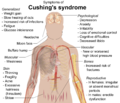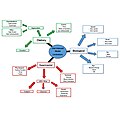Diet-induced obesity model
Diet-induced obesity model is a widely used experimental model in biomedical research that mimics the human condition of obesity and its associated metabolic disorders. This model is created by feeding animals, usually rodents, a high-fat diet (HFD) that is rich in saturated fats and sugars.
Overview
The Diet-induced obesity model is a research tool used to study the physiological and molecular mechanisms underlying obesity and its related metabolic disorders such as type 2 diabetes, cardiovascular disease, and non-alcoholic fatty liver disease. The model is created by feeding animals, usually rodents, a high-fat diet (HFD) that is rich in saturated fats and sugars. The HFD induces obesity and metabolic disorders in the animals, which can then be studied to understand the pathogenesis of these conditions in humans.
Mechanism
The mechanism of diet-induced obesity involves the overconsumption of energy-dense foods, leading to an energy imbalance and excess fat accumulation. The HFD induces insulin resistance, a key feature of metabolic syndrome, by increasing the levels of free fatty acids and inflammatory cytokines in the body. These factors interfere with insulin signaling, leading to impaired glucose uptake and hyperglycemia.
Applications
The diet-induced obesity model is used in various areas of biomedical research. It is used to study the pathogenesis of obesity and its related metabolic disorders, to test the efficacy of anti-obesity drugs, and to investigate the effects of dietary interventions on obesity and metabolic health.
Limitations
While the diet-induced obesity model is a valuable tool in obesity research, it has some limitations. Not all animals fed a HFD develop obesity and metabolic disorders, reflecting the genetic and environmental factors that contribute to these conditions in humans. Furthermore, the model does not fully replicate the complex etiology of human obesity, which involves not only diet but also factors such as physical activity, sleep, and stress.
See also
Transform your life with W8MD's budget GLP-1 injections from $125.
W8MD offers a medical weight loss program to lose weight in Philadelphia. Our physician-supervised medical weight loss provides:
- Most insurances accepted or discounted self-pay rates. We will obtain insurance prior authorizations if needed.
- Generic GLP1 weight loss injections from $125 for the starting dose.
- Also offer prescription weight loss medications including Phentermine, Qsymia, Diethylpropion, Contrave etc.
NYC weight loss doctor appointments
Start your NYC weight loss journey today at our NYC medical weight loss and Philadelphia medical weight loss clinics.
- Call 718-946-5500 to lose weight in NYC or for medical weight loss in Philadelphia 215-676-2334.
- Tags:NYC medical weight loss, Philadelphia lose weight Zepbound NYC, Budget GLP1 weight loss injections, Wegovy Philadelphia, Wegovy NYC, Philadelphia medical weight loss, Brookly weight loss and Wegovy NYC
|
WikiMD's Wellness Encyclopedia |
| Let Food Be Thy Medicine Medicine Thy Food - Hippocrates |
Medical Disclaimer: WikiMD is not a substitute for professional medical advice. The information on WikiMD is provided as an information resource only, may be incorrect, outdated or misleading, and is not to be used or relied on for any diagnostic or treatment purposes. Please consult your health care provider before making any healthcare decisions or for guidance about a specific medical condition. WikiMD expressly disclaims responsibility, and shall have no liability, for any damages, loss, injury, or liability whatsoever suffered as a result of your reliance on the information contained in this site. By visiting this site you agree to the foregoing terms and conditions, which may from time to time be changed or supplemented by WikiMD. If you do not agree to the foregoing terms and conditions, you should not enter or use this site. See full disclaimer.
Credits:Most images are courtesy of Wikimedia commons, and templates, categories Wikipedia, licensed under CC BY SA or similar.
Contributors: Prab R. Tumpati, MD





